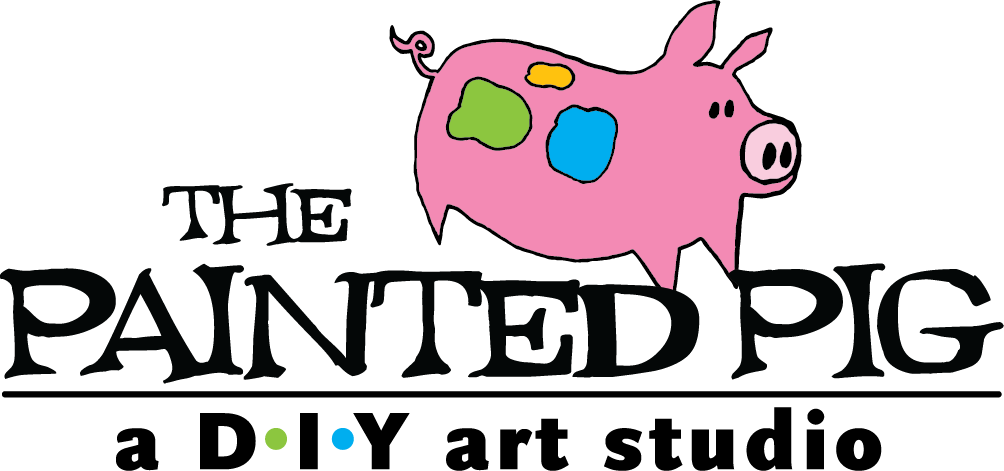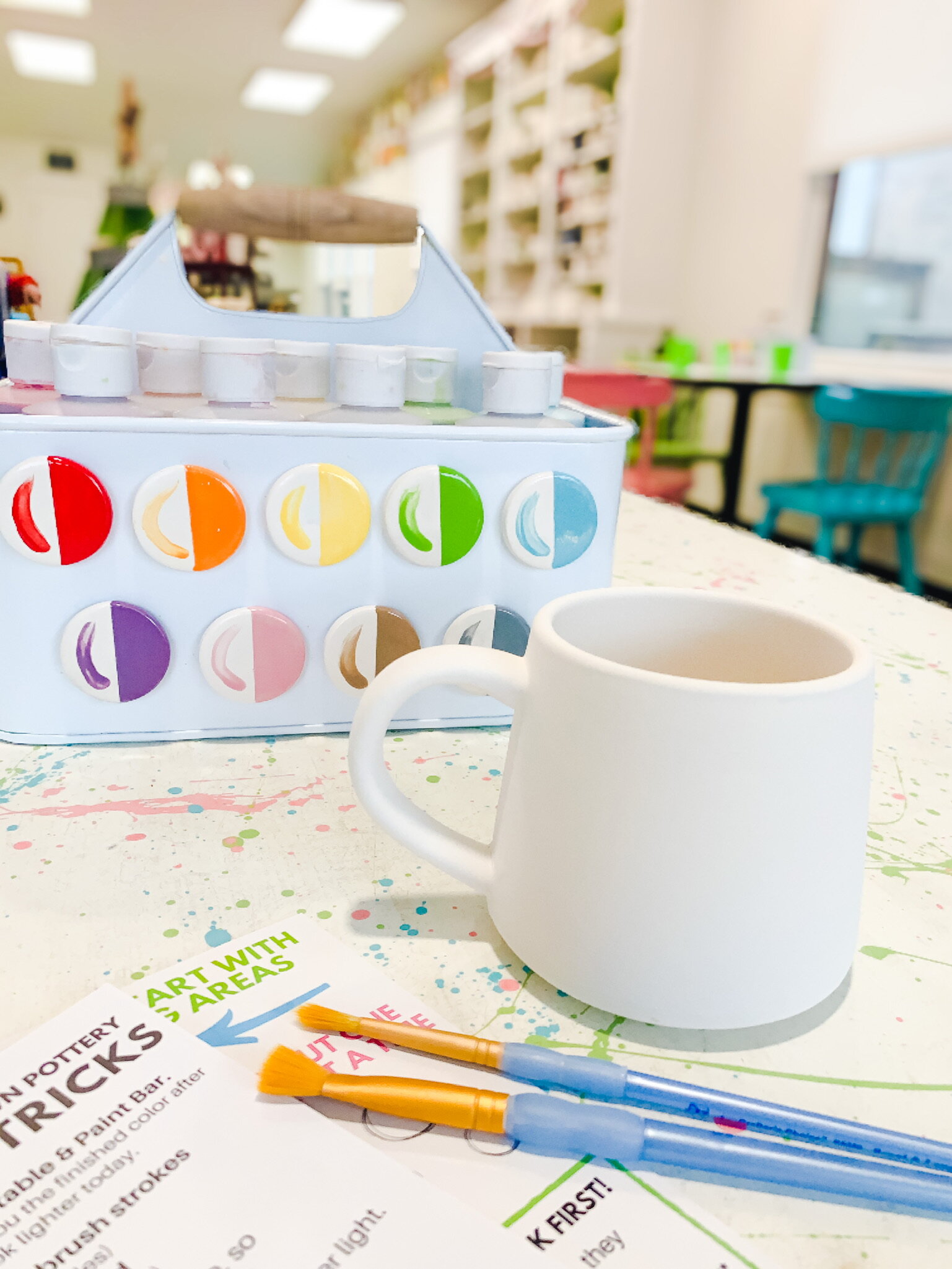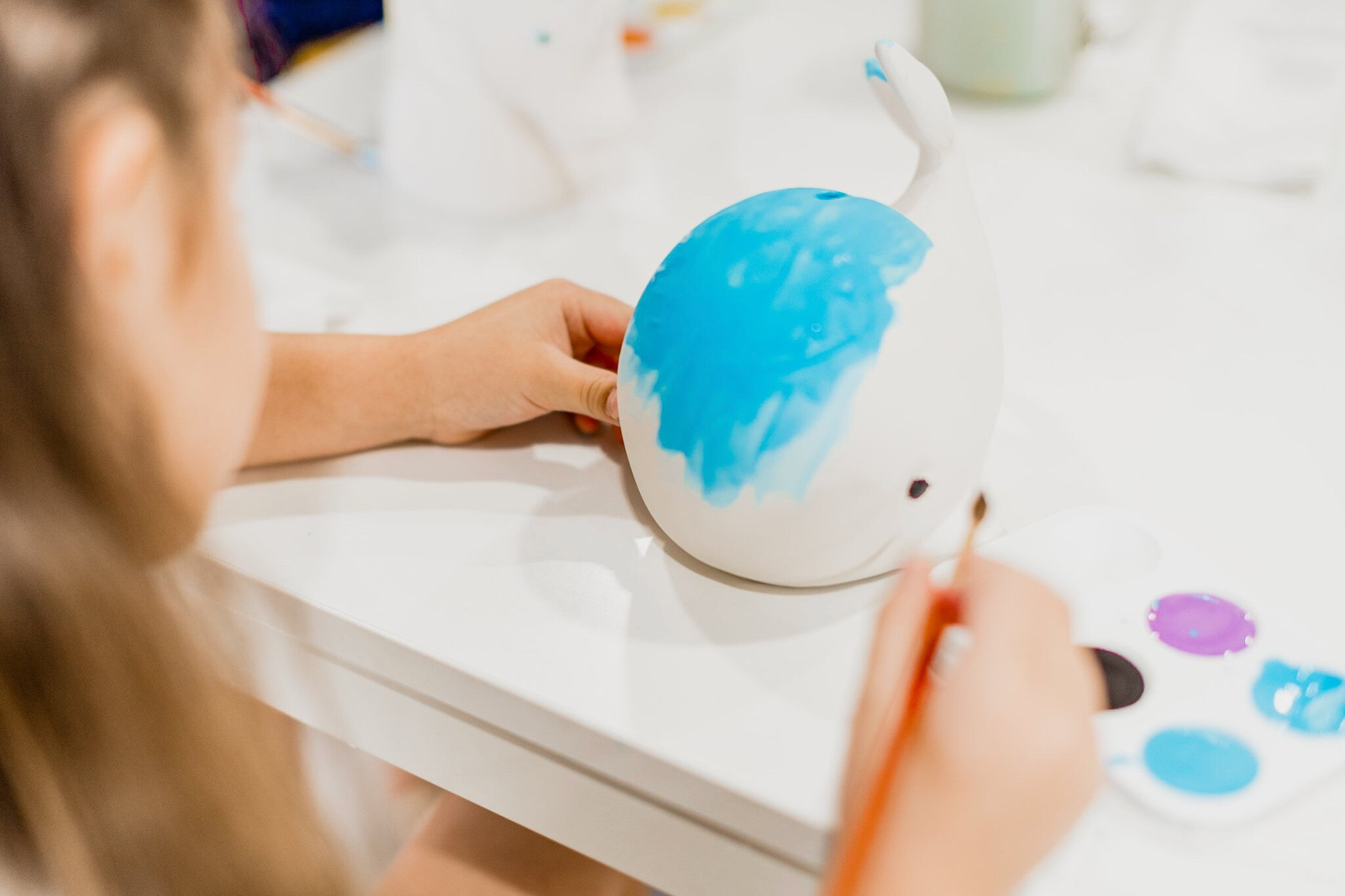Pottery
Most of our customers will be in to paint pottery that is pre-formed bisque. Bisque is the state that this pottery is in. It is clay that was fired once and is now ready to be painted! If they are veterans of the studio, they will know most of the ins and outs, but ask them if they need any reminders. Tell them you are here for them if they have any questions or need a paint bar refresher.
If they are new, it is our responsibility to help them understand all the wonders of painting pottery. Pay close attention to them, so that they may avoid some of the pitfalls that can occur.
First, let’s find them a place to sit. Ask them if they have a particular table in mind. If not, seat them at an appropriately sized table for their group. Walk with them and show them to their table, don’t just point.
Let them know that it is okay to leave their things at the table to peruse the bisque while they choose their pieces, and you will return once they have their selections. They are more than welcome to take the pieces off the shelf themselves. Please help them with pieces that are too high to reach. Explain the pricing.
While they are looking, you will set up their table.
The table will need:
Paint Caddy with top 8 paints
Brushes
Paper Napkins
Palettes or Paper Disposable Pallet
Cup of water for each painter
Once they have made their selections, have them set their pieces on the table, and then invite them to follow you to the Paint Station.
This next part is very important. You will be giving out a lot of information in a short period of time. The “Paint Talk” is very valuable but must be given in such a way that our guests stay interested and engaged in the speaker. (That’s you) Use both your voice and examples to show them the best ways to accomplish their artistic goals. Here we go!
(The following is written as a monologue. It is important to breathe and let them ask questions. Find your own style and way to say things. Remember to gauge your audience. 6 year olds will not pay attention as long as adults.)
The Paint Talk
“Choose your colors according to the examples you see before you. (Point to the examples)
As you can see here (pointing to one coat) one coat of paint can be very translucent and look much like watercolors. Three coats of paint will give you a more solid look. If you want a more solid look it is important to let your paint dry between coats.
When layering colors remember to paint light colors first then the darker colors on top of them. (repeat Lights first, Darks second.) Anything you don’t paint will be the color of the piece but we will clear glaze it for you so it will still be nice and shiny.
To find your paint bottle, look at the circle tile first, and the number on it will correspond with the last two digits on the paint bottle. The funwriters (point) are the same colors, just in an easy squeeze tube for writing or designs. You only need one coat when using the funwriters. The Fleckle paints do not have numbers, and are found in the big bottles below the regular paints. These are special paints and will have “sand” in them. That is what makes the fleckle and is normal!
If you make a mistake most of the colors will wipe off with a cotton swab or damp sponge. Some of the darker colors may stain the piece a little if you paint over the stain it shouldn’t show through. You can also use sandpaper to fix this.
Feel free to design your piece in marker first. Washable markers will disappear during firing.
There are sponges to sponge paint with (Use the Dab, dab, dab motion.) and toothbrushes to speckle with (show example of each of these techniques on the example plate.)
We also have sgraffito or etching tools. The best way to use these is to paint your piece first then scrape the paint away. This is a great way to make designs or write words. We have examples over here (point to plates) of all of our techniques.
We also offer silkscreens, which are easiest to put on bare bisque and then paint around. Let me know if you would like to see how this works.
We also have carbon paper behind the desk for tracing a logo or image straight onto your pottery. Ask me for help if this is something you are interested in.
Now, I know that is a lot of information. Do you have any questions? Okay great, lets grab your paints and tools. My name is ______ and I will drop by your table in a few minutes to see how you are doing.”
(Please show them how much paint to pour out, you really don’t need a lot and you would be amazed at the waste we see!)
While They Are Painting
It is important to take care of each guest to the best of our ability. Each customer will have different needs and we must be able to perceive those needs, sometimes even before they do. There will be guests that like nothing better to be left alone and will quietly work for hours without much attention from us. There will be others that need much more help.
Here are some things to remember as our guests are painting:
• They will dirty their water. Change it for them without having to be asked. This task should be done with little fanfare. Quietly exchange the cups and walk away.
• As you walk around pay attention to the little things. Some things to look for:
Dried or unused palettes. Take them away.
If they are having a difficult time with a fun writer help show them how to make it work.
Trash. Take away empty bottles and coffee cups. (Ask first)
Look for possible threats to the quality of their piece. For example-If they are about to paint their entire piece black, politely inquire as to the nature of their goal. It is possible that they want a black platter but let’s check just in case.
If they are beginning to run out of a color bring them a new bottle and take the empty to be refilled.
Though it isn’t necessary to check in constantly it is a good idea to drop by and see how everything is going. You will be able to tell those that “need” you and those that just want to sail solo.
Our aim is to make sure that the guest experience is not just good but extraordinary. We want to do everything in our power to help them enjoy their time with us. This type of experience will bring them back again and again.
Breakage Policy
“Whoops I dropped it!” Pieces get dropped sometimes. It’s okay. The best thing to do is reassure the person who dropped it that is isn’t a big deal and then clean up the mess. We do not charge customers for the piece if it truly was an accident and it was small. If we are still firing it though, no discount. That price includes the paint, glaze, and firing, and now being broken, it’s even more work to fire irregular small pieces. Sometimes it is impossible. Use your judgment, and do what is fair. If it is a piece that they had been painting all day, be very compassionate. They have just watched their entire day’s work go down the drain.
Unfinished Pottery Policy
We do NOT hold unfinished projects. (Pottery, glass, or mosaics!) We have nowhere to put it. If a customer is not finished with a piece, we wrap it up and let them take it home after they have paid. If the piece is still wet, let them dry it on the cool setting with a hair dryer. Write their colors down for them on a note or tell them to take a photo of the paint bottles. . Inform them that they can come back anytime during store hours and there is no extra charge.
They are Finished, Now What?
Once a guest is finished painting they will often start to clean up their tables. We really appreciate their willingness to clean up but think back. Have you ever eaten at a restaurant then had to bus and clean your own dishes? Let’s hope not.
Politely tell the guest that we will take care of all of the mess and that you would be happy to ring them up at the check-out counter.
Checking out-
If the items are dry-make sure the items all have names on them. Initials are great. You can have them write in permanent pencil, or paint. If a plate has a name on it already, it is unnecessary to write it on the bottom too, unless it is illegible.
Next, it is helpful to write on a scratch piece of paper what they painted beforehand and ring up their items before they are ready. But always double check for added items, because sometimes little pieces will appear on the table after the customers are out of the store, and this is a lost sale. You can start a ticket on the register and “park” it until you are ready to finish the sale. This is especially helpful during our busier seasons.
Ask the guest for their name and phone number. If they are in our computer it will pop up right away. If not, enter them as a new guest. (Some people will balk at the thought of giving us their phone number. Let them know we only use it if we need to text them when their piece is ready or needs a little extra TLC.) Always read the phone # back to them, and always check that existing customers have not gotten a new phone number. This is also a great time to ask them if they would like to be on our VIP email list. You can add their email and turn on their loyalty in their customer information.
Enter the guest pieces in the computer. Please double-check that you are ringing up the correct plate or mug. We keep a tight inventory list. There is a difference between a square coupe salad plate and a coupe salad plate, for instance.
Once the pieces are in the system tell the guest their total.
We accept Cash, Visa, Mastercard, Discover, and American Express. We do not accept checks except from certain schools and businesses. (Local only, we write the state and liscence # on top.) Give them a copy of our receipt and a Credit Card receipt copy (not the signed one). Print off a copy of their receipt for our ticket we will write in a minute.
Once the transaction has gone through, tell them about when we will call (7-10 days, 10-15 days, 2 weeks check the plate by the register), and thank them for their visit.
After they leave, take the extra itemized receipt, and describe each piece after its title. Make sure to give colors, details, this will help match it later. This is very important. Be precise without being wordy. Make sure to have the Name, date, and Phone # on the ticket.
Pieces to the kiln room-
The pieces will be put in the back on the “Waiting to be Glazed” shelf. Be careful with the pieces as they may still be a little damp and need to be handled as such. Do not stack the pieces until they are dry. When dry, you can stack pieces with bubble wrap or paper towels in between. It is important to keep all the pieces in order. We fill up the shelf from left to right, from the top shelf working downwards. The very top shelf is for Rushes and Custom Orders only.
Back to the table-
The guest’s table will now need to be:
Cleared- Take all the brushes and palettes to the sinks to be washed. Paint bottles need to be cleaned and restocked. All other tools to their proper place. Trash in its proper place.
Wiped- Wipe the table, chair, turn tables and floor. Sometimes even the wall or window will need some attention. It depends on how messy they were. Disenfect! Some sprays need to be wet and stay on a surface from 30 seconds to 5 minutes before being wiped off.
Cleaning the Palettes and Brushes etc…
The brushes, sponges and palettes should be cleaned immediately after use. Palettes may be rinsed and set to dry in the drying rack. Brushes should be rinsed and free of paint before being disinfected in the jars (handles only should be wet, not the metal part holding the bristles in). Sponges should be rinsed and returned to their proper place for reuse. Make sure to wipe down the counter and sink after you are finished.








